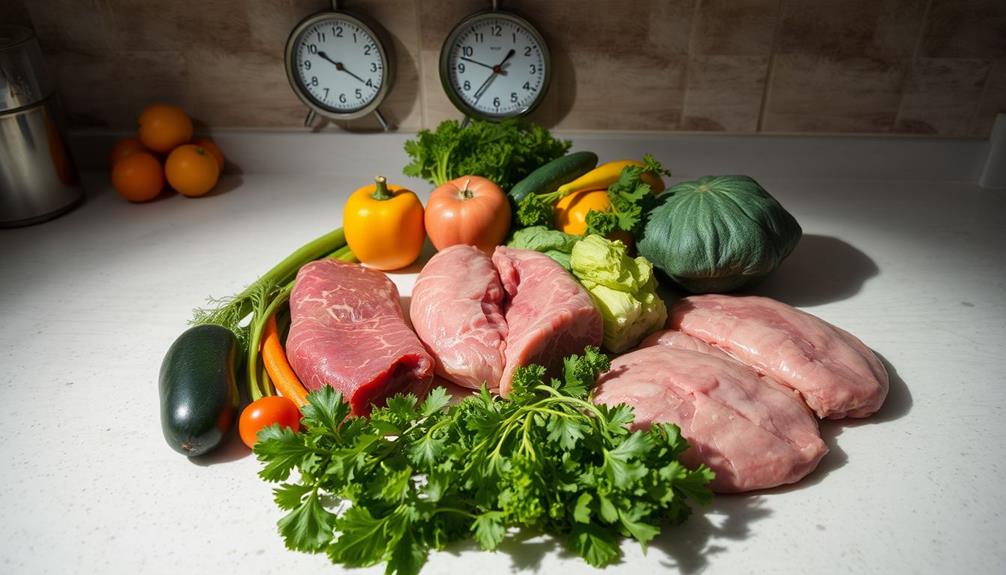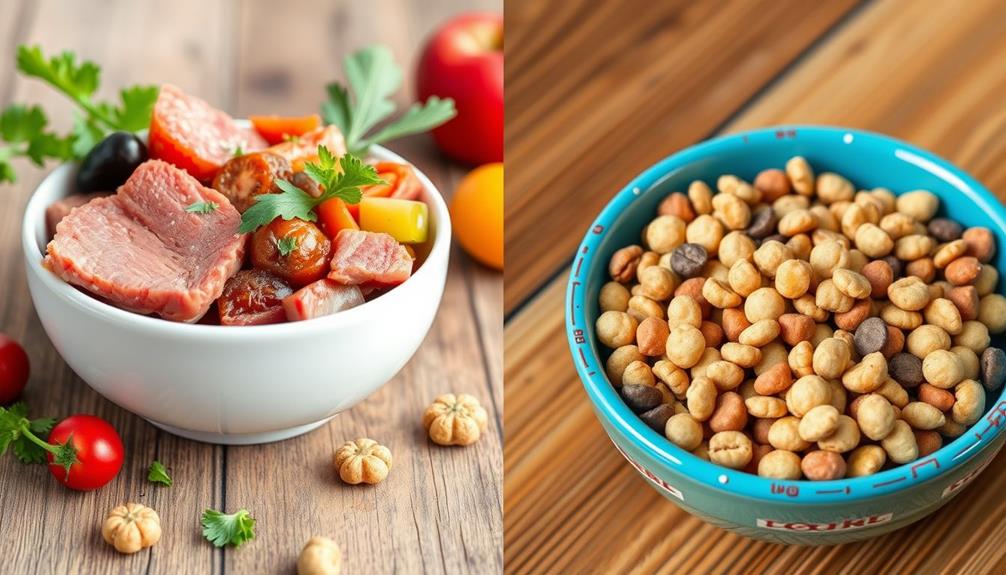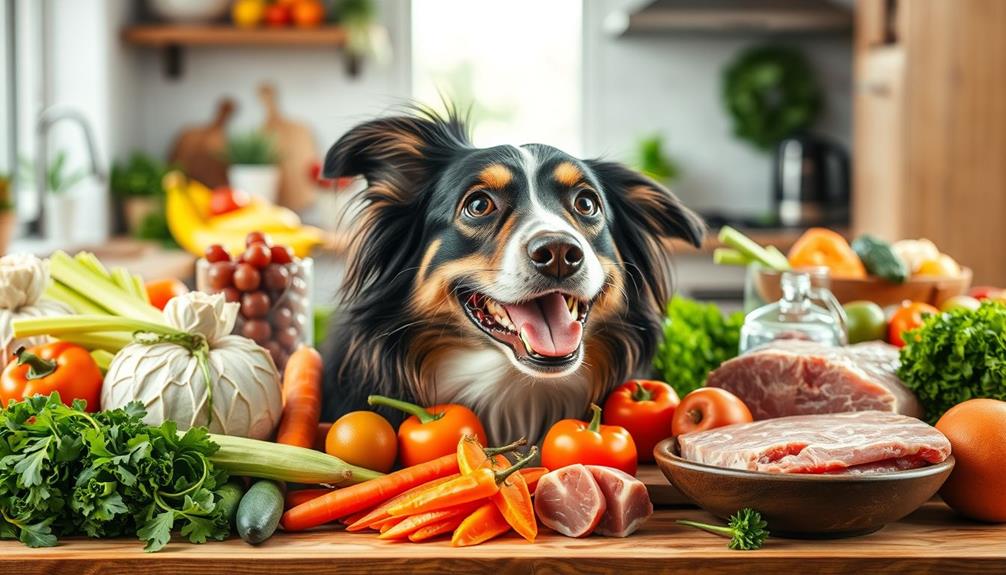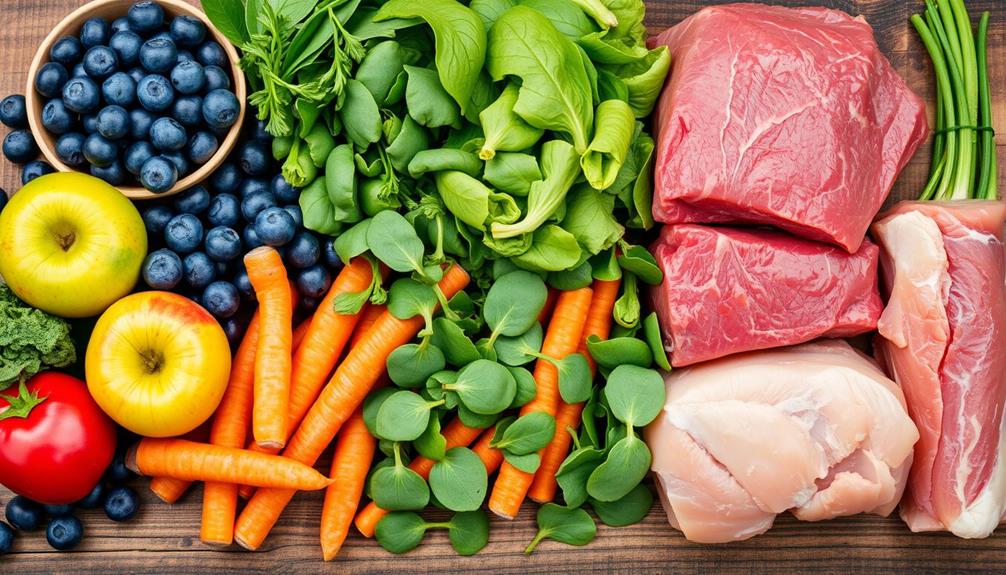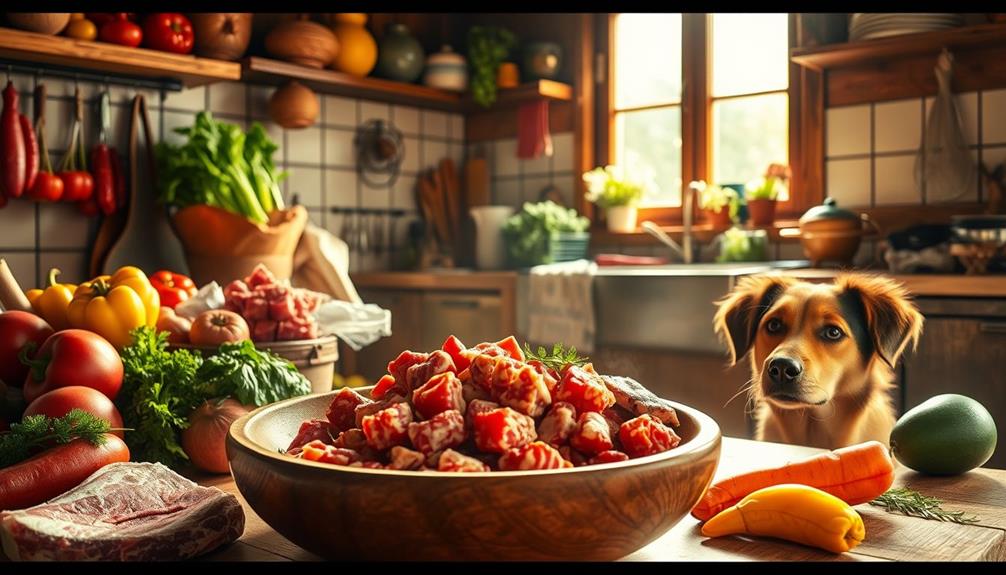Raw food shouldn't be left out at room temperature for more than two hours. If it's over 90°F, cut that time down to just one hour. Bacteria love the "Danger Zone" (40°F to 140°F) where they double every 20 minutes. To minimize risk, try to limit exposure to just 10-15 minutes for perishable items like meats. Always check for signs of spoilage, such as bad odors or a slimy texture, as these indicate food safety issues. Want to guarantee your food stays fresh and safe? There are essential tips just ahead that can help.
Key Takeaways
- Raw food should not be left out at room temperature for more than 2 hours, or 1 hour if temperatures exceed 90°F.
- Perishable foods, especially meats and poultry, should ideally be exposed to room temperature for only 10-15 minutes to minimize bacterial growth.
- Always refrigerate leftovers within 2 hours of serving to reduce the risk of harmful pathogens.
- Monitor raw food for spoilage signs such as unpleasant odors, discoloration, slimy texture, or mold before consumption.
- Use separate utensils for raw food and store it in airtight packaging to prevent cross-contamination and ensure safety.
Understanding Raw Food Safety
Understanding raw food safety is essential for preventing foodborne illnesses. You need to be aware that raw food shouldn't sit out at room temperature for more than two hours. If it's over 90°F, the time limit drops to just one hour. This is critical because bacteria thrive between 40°F and 140°F, known as the "Danger Zone," where they can double in number every 20 minutes.
Additionally, similar to the precautions taken for cold medications, it's important to be mindful of food storage and handling practices to minimize health risks.
Before you serve raw food, always check for signs of spoilage. Look out for unpleasant odors, discoloration, a slimy texture, or any mold. These indicators can help you avoid foodborne illness and guarantee food safety.
Refrigeration is your best friend in slowing down bacterial growth. Store raw food at 40°F or below to maintain its safety.
Also, it's essential to practice good hygiene in the kitchen. Avoid cross-contamination by using separate utensils and surfaces for raw food and cooked food.
Time Limits for Raw Foods
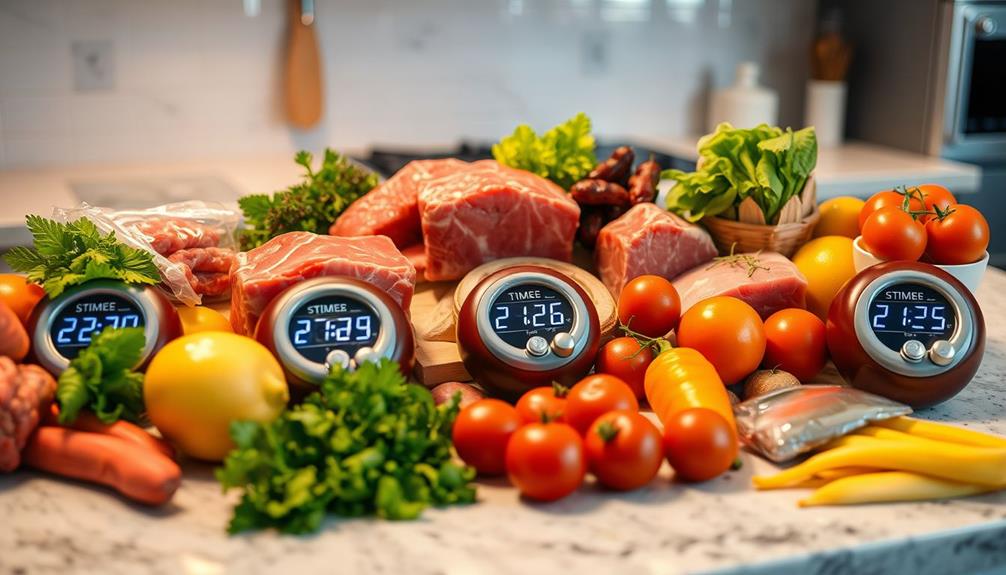
When it comes to raw foods, you need to be aware of how long they can safely sit out.
Ice cream, for example, is prone to melting and can become unsafe to consume if left at room temperature for too long, as it can encourage bacterial growth and spoilage high sugar and fat content.
After just 2 hours at room temperature, bacterial growth can pose serious health risks, and that time drops to 1 hour in warmer conditions.
Always keep an eye on how long your food's been exposed to avoid any unpleasant surprises.
Safe Exposure Duration
Raw food safety hinges on time limits for exposure at room temperature. You should never leave raw food out for more than 2 hours to prevent bacterial growth. If the temperature exceeds 90°F, that limit drops to just 1 hour. For high-risk items like meats and poultry, it's best to minimize exposure even further, ideally limiting it to 10-15 minutes. Proper food handling is essential, akin to the importance of regular health checks for pets like hamsters, as both practices help prevent issues routine health checks.
Understanding safe exposure duration is vital because bacteria can double in number in as little as 20 minutes when food sits in the Danger Zone, defined as temperatures between 40°F and 140°F. To keep raw food safe, always refrigerate it at 40°F or below when it's not in use.
Always be vigilant for signs of spoilage, such as unpleasant odors or discoloration, especially if the food has been left out for any period. By adhering to these time limits and monitoring your raw food, you can greatly reduce the risk of foodborne illness.
Bacteria Growth Risks
Leaving raw food out too long can lead to dangerous levels of bacteria growth, putting your health at risk. Bacteria can grow rapidly, especially when raw food is left at ambient temperature for more than two hours. In fact, if the temperature exceeds 90°F, that time limit drops to just one hour.
After two hours, bacteria can double in number every 20 minutes, greatly increasing the risk of foodborne illness. To guarantee safety, it's also important to take into account financial considerations for elderly care when managing meal preparation and storage, as this can impact food safety practices.
To avoid unsafe food handling practices, always keep raw food refrigerated at or below 40°F. This slows down bacterial growth and helps maintain food safety. Before serving, it's essential to check for spoilage signs, such as unpleasant odors or discoloration.
Keep in mind, though, that bacteria may not always alter the food's appearance or smell, so don't solely rely on your senses.
The 2-Hour Rule Explained

When it comes to food safety, you need to remember the 2-hour rule. Leaving perishable foods out for more than two hours can lead to dangerous bacteria growth, especially in the "Danger Zone."
It's important to maintain proper disposal habits to prevent foodborne illnesses, just as you'd in ensuring toilet maintenance and repairs are conducted regularly.
If the temperature's above 90°F, cut that time down to just 1 hour to keep your food safe.
Time Limits for Safety
For safety's sake, perishable foods should never be left out at room temperature for more than 2 hours. This rule is vital for all types of perishable foods, including raw meat, to minimize the risk of bacterial growth.
When food is left out, bacteria can multiply rapidly, leading to potential foodborne illnesses. It's important to have a clear plan for managing your food safety, much like creating a budget to manage your finances. Understanding strategies like budgeting for emergencies can help you prepare for unexpected situations.
In hot weather, when temperatures exceed 90°F, this time limit drops to just 1 hour. It's important to take into account the total time food spends outside refrigeration, including during transportation.
If you've catered a picnic or a gathering, remember that refrigerated leftovers must be stored within 2 hours of serving to keep them safe.
Ignoring these time limits for safety can result in consuming food that's been sitting out too long, greatly increasing the risk of harmful pathogens. Always keep an eye on the clock and make sure you're storing or consuming your perishable foods promptly.
Bacteria Growth Risks
Understanding the risks of bacteria growth is key to food safety. Perishable foods, especially raw food like meat, shouldn't be left out at room temperature for more than 2 hours. This rule is essential because, within the Danger Zone of 40°F to 140°F, bacteria can double in number every 20 minutes.
If the room temperature exceeds 90°F, this time limit shrinks to just 1 hour. To maintain a clean environment and reduce the risk of contamination, consider using an air purifier to improve overall air quality around food preparation areas, ensuring a safer cooking space while also supporting air quality considerations.
Ignoring these guidelines can lead to serious foodborne illnesses. You might think it's safe to taste food to check for spoilage, but harmful bacteria often don't change the food's appearance, taste, or smell.
Remember, transportation time also counts toward the 2-hour limit, so make sure to refrigerate leftovers promptly after serving.
To keep your meals safe, always monitor how long raw food sits out. Staying vigilant about bacteria growth can prevent nasty surprises later. Prioritize food safety to protect yourself and your loved ones from potential health risks.
Impact of Temperature on Safety

Temperature plays an important role in food safety, especially when it comes to raw ingredients. You should never leave raw food out at room temperature for more than 2 hours. If the temperature exceeds 90°F, that limit drops to just 1 hour. This is vital because bacteria thrive in what's known as the "Danger Zone," which ranges from 40°F to 140°F.
Within this zone, bacteria can double in number every 20 minutes, increasing the risk of foodborne illness. To guarantee food maintains its quality, consider how butter storage practices can help in preventing spoilage in similar contexts.
To keep your raw food safe, always refrigerate it at temperatures of 40°F or below. This greatly slows bacterial growth, allowing you to preserve your food longer.
While preparing your meals, keep an eye on the ambient temperature. Higher temperatures can decrease the safe time limit for leaving food out, so it's important to act quickly.
Recognizing Spoilage Signs
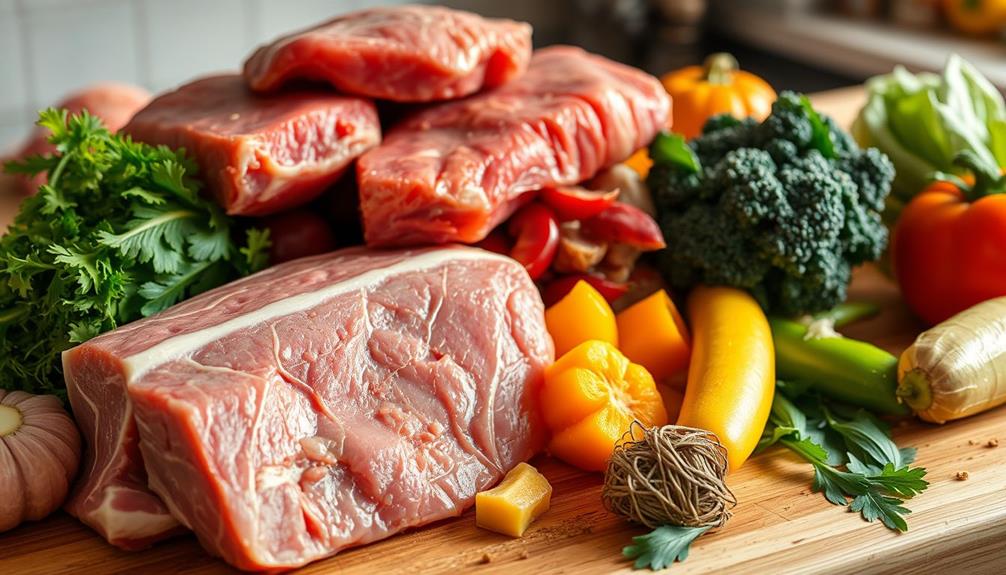
How can you tell if raw food has spoiled? Recognizing spoilage signs is essential to preventing foodborne illness. Always inspect your raw meat and other perishables. Look for unpleasant odors, discoloration, a slimy texture, or even mold. If you spot any of these signs, it's best to toss the food rather than risk your health.
| Spoilage Signs | Action |
|---|---|
| Unpleasant odors | Discard immediately |
| Discoloration | Discard immediately |
| Slimy texture | Discard immediately |
| Presence of mold | Discard immediately |
Best Practices for Storage

After identifying spoilage signs, proper storage of raw food becomes your next line of defense against foodborne illness. To guarantee food safety, never leave food out at room temperature for more than two hours. If the temperature exceeds 90°F, that limit drops to just one hour. Always refrigerate raw food promptly, ideally at or below 40°F, to slow down bacterial growth.
Additionally, consider using vital oils like eucalyptus oil for their antimicrobial properties, which can help maintain a clean and safe kitchen environment.
When it comes to raw meats, store them in airtight packaging. This not only prevents cross-contamination but also helps avoid freezer burn if you're freezing for extended periods. If you need to thaw raw food, do so in the refrigerator rather than at room temperature. This method minimizes the risk of bacterial growth, keeping your food safe.
Lastly, keep an eye on your raw food even during storage. Check for any unpleasant odors or discoloration before serving. By following these best practices for storage, you can greatly reduce the risk of foodborne illness and enjoy your meals with peace of mind.
Types of Raw Foods
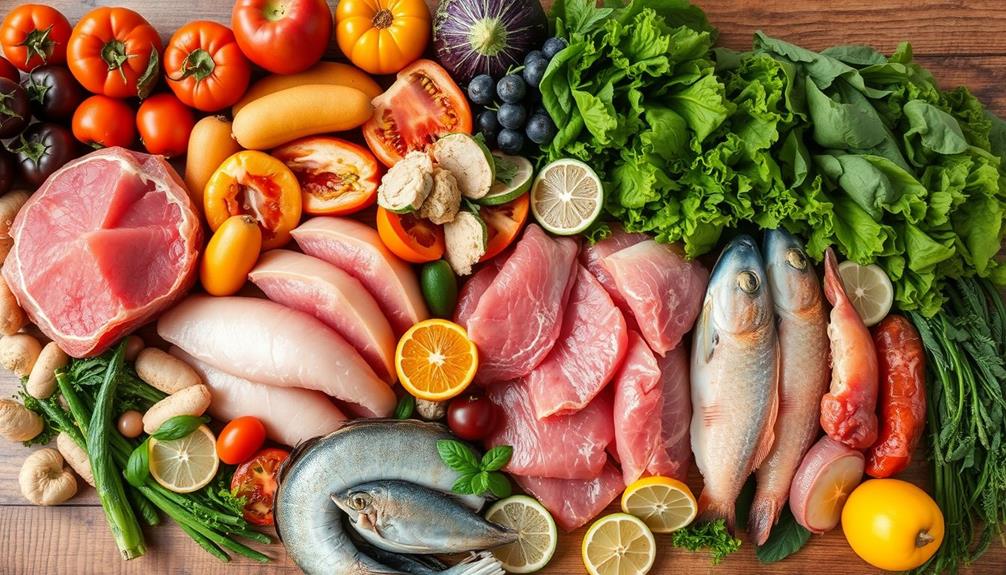
When it comes to raw foods, you'll commonly encounter meat, poultry, fish, and fresh fruits and vegetables.
It's crucial to recognize that chia seeds can also be included in raw food preparations due to their versatility and health benefits.
Be cautious with raw eggs, as they can pose a risk of Salmonella, and always monitor any bone content in your preparations to avoid choking hazards.
Understanding these types of raw foods and their associated risks is essential for safe handling and consumption.
Common Raw Food Types
Understanding the common types of raw foods is essential for safe food handling and preparation. You'll encounter various raw food types, including raw chicken, beef, pork, lamb, fish like salmon and tuna, and even organ meats such as liver and kidney.
When you handle these items, be sure to keep them separate from other foods to prevent cross-contamination.
Raw fruits and vegetables are also popular in many diets. Even if they're labeled as pre-washed, it's important to wash them thoroughly before consumption to reduce the risk of harmful bacteria.
Remember, the safety of your food is paramount, especially when raw food is left out for too long.
While this section doesn't cover eggs, you should be aware that they pose a higher risk of Salmonella and require careful handling.
Additionally, if you're feeding pets any raw food, keep an eye on bone content to avoid choking hazards.
Risks of Raw Eggs
Raw eggs present specific risks that everyone should be aware of, particularly due to their potential to harbor Salmonella bacteria. This bacterium can lead to serious foodborne illnesses, so it's essential to handle and store raw eggs safely. The CDC estimates about 1 in 20,000 eggs may be contaminated, underscoring the need for proper food safety practices.
To minimize risks, always refrigerate raw eggs at 40°F (4°C) or below, since bacteria can multiply quickly at higher temperatures. It's best to avoid consuming raw or undercooked eggs, especially for vulnerable populations like pregnant women, the elderly, and those with weakened immune systems.
When you're handling eggs, always check the expiration date on the carton. If you find any eggs with cracks or unusual odors, discard them immediately, as these signs could indicate spoilage or contamination.
Monitoring Bone Content
Attention to bone content in raw foods is essential for guaranteeing the safety and health of your pets. Bones can pose serious choking hazards, especially for smaller animals like kittens.
To keep your pets safe, follow these guidelines:
- Choose the Right Bones: Opt for softer, raw bones that are less likely to splinter. Avoid cooked bones at all costs.
- Monitor Size: Make sure the bone is appropriately sized for your pet. It shouldn't be so large that they can't chew it, nor so small that they could swallow it whole.
- Limit Time Left Out: Remember, raw foods shouldn't be left out at room temperature for more than 2 hours, or 1 hour in hot weather, to prevent bacteria from multiplying.
- Check for Cleanliness: Always wash raw fruits and vegetables thoroughly to remove harmful bacteria before serving.
Serving Raw Food Safely
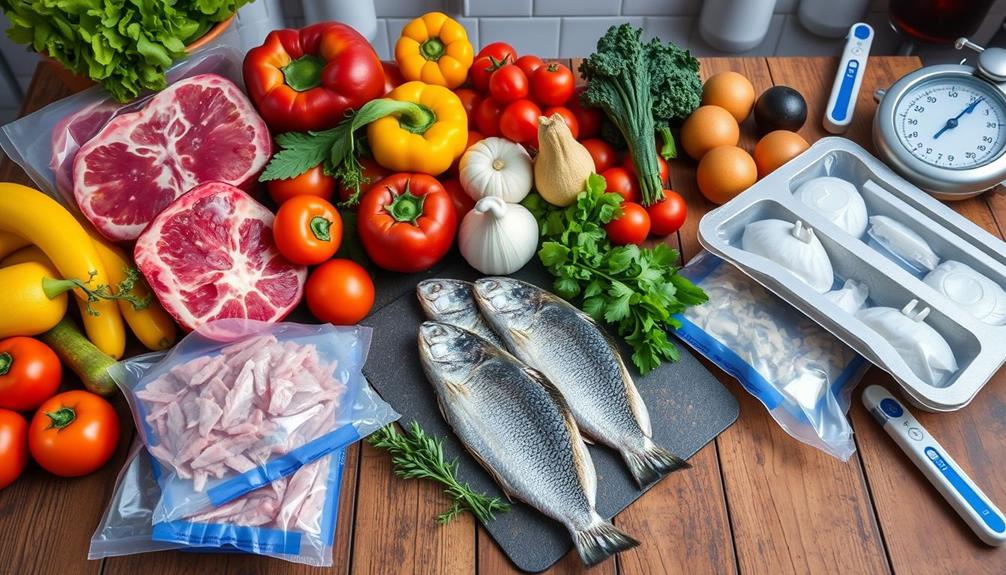
When it comes to serving raw food, timing is crucial to guarantee safety and freshness. You shouldn't leave raw food out at room temperature for more than 10-15 minutes. In moderate temperatures, a maximum of 30 minutes is acceptable, but it's best to serve it straight from the refrigerator. This minimizes the time it spends at unsafe temperatures and helps prevent bacterial growth.
To further guarantee safety, portion out raw food meals before serving. This way, you can avoid excess food left out, reducing the risk of spoilage. Always use separate utensils for raw food to prevent cross-contamination, and remember to clean feeding areas thoroughly after each meal.
Additionally, keep a close eye on your pets during feeding. Monitoring their consumption closely helps you address any potential health risks associated with raw food.
Outdoor Food Safety Tips
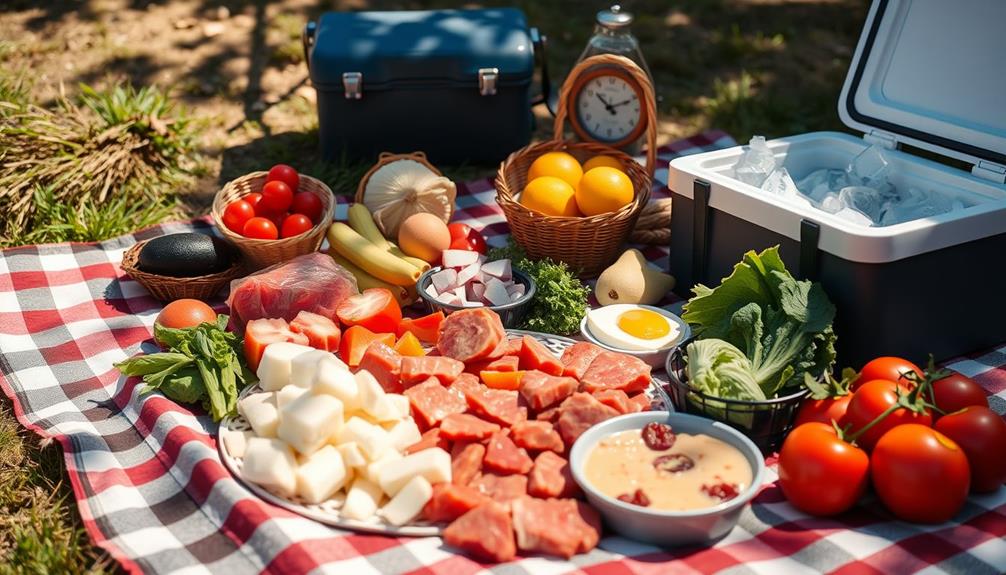
Outdoor gatherings can be a great way to enjoy food and company, but keeping your meals safe is essential. Follow these tips to guarantee your food remains safe during outdoor events:
- Limit Time at Room Temperature: Don't let perishable foods sit out for more than 2 hours at room temperature. If it's over 90°F, reduce that time to just 1 hour.
- Use a Cooler: Keep cold food in a cooler packed with ice to maintain a temperature of 40°F or below. This helps prevent spoilage.
- Organize Your Cooler: Place frequently accessed items on top to minimize exposure to warm air. Close the cooler lid quickly to keep the cold in.
- Prevent Cross-Contamination: Always keep raw foods separately wrapped and use different utensils for raw and cooked items.
Also, remember to wash fresh produce thoroughly before packing to eliminate harmful bacteria.
Observations on Pet Eating Habits

Observing your pet's eating habits can reveal a lot about their preferences and health. For instance, if you leave raw food out for too long, your cat might refuse to eat it due to their keen sense of smell, which enables them to detect spoilage better than you can.
Many pet owners notice that their cats can be less picky about food left out during cooler months, but this isn't a universal rule. You might find that raw food left out overnight often leads to your cat turning its nose up at breakfast. This highlights the varying behaviors among different cats.
To combat spoilage, consider using automatic feeders that serve fresh meals straight from the refrigerator, guaranteeing your pet gets the best quality food.
Even though some cats enjoy food with a crusty texture, prioritizing freshness is key for most owners. By monitoring your pet closely during feeding times, you can help guarantee they consume safe, appetizing food, ultimately supporting their health and happiness.
Frequently Asked Questions
How Long Can Raw Food Sit Out For?
Raw food can't sit out for too long. Generally, you should keep it out for no more than 2 hours. In hot weather, it's best to limit that time to just 1 hour. If you plan on having raw food out for longer periods of time, it’s important to keep it cold to prevent bacterial growth. Storing raw food in the fridge can help maintain its freshness and reduce the risk of foodborne illness. Additionally, properly sealing and storing raw food in airtight containers can also help preserve its quality and prevent it from spoiling.
How Long Can I Leave Raw Dog Food Out For?
If you leave raw dog food out during a summer BBQ, it can sit for just 2 hours—1 hour if it's hot outside. Always discard leftovers after this time to keep your pup safe and healthy.
How Long Can I Leave Raw Cat Food Out For?
You shouldn't leave raw cat food out for more than 2 hours, or 1 hour in hot weather. Always serve it cold from the fridge, and use separate utensils to avoid cross-contamination.
How Long Can Food Be Left Out Before Unsafe?
Imagine a ticking clock, each second counting down your food's safety. You shouldn't let perishable food linger out for over two hours. In heat, that time shrinks to one hour—so act fast to keep it safe!
Conclusion
In summary, keeping raw food safe is essential for your health. Did you know that nearly 48 million people get sick from foodborne illnesses each year in the U.S. alone? To protect yourself and your loved ones, always follow the 2-hour rule and pay attention to temperature. By being aware of spoilage signs and practicing safe food handling, you can enjoy your meals worry-free. Stay informed and keep your kitchen a haven of safety and deliciousness!

